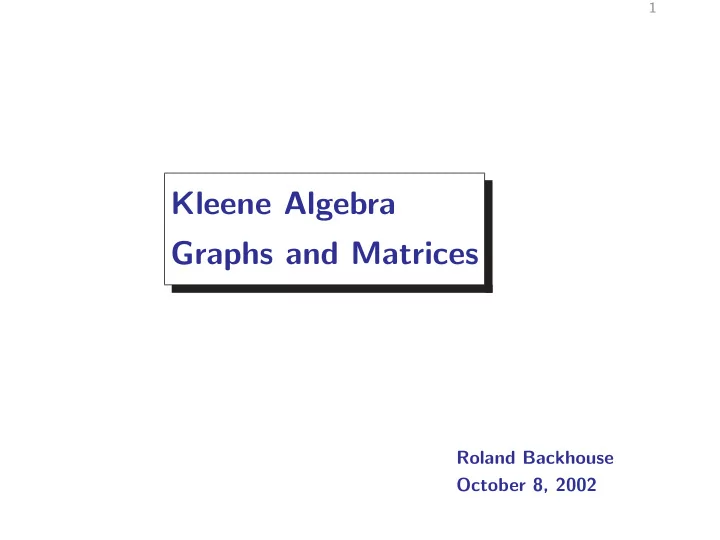

1 Kleene Algebra Graphs and Matrices Roland Backhouse October 8, 2002
2 Outline • Matrices represent graphs • Addition as choice • Matrix multiplication as edge concatenation • Powers as paths of given edge length
3 Extremal Path Problems ✗✔ ✗✔ 3 ✲ a b ✖✕ ✖✕ ❅ ✻ ❅ ❅ 5 2 ❅ 4 ❅ ❅ ✗✔ ✗✔ ❄ ❅ ❘ 2 ✛ ✲ d c ✖✕ ✖✕ 8 A graph consists of a finite set of nodes , V , a finite set of edges , E and two functions source and target , each with domain E and range V . A path through the graph from node s to node t of edge length n is a finite sequence of nodes x 0 , x 1 , . . . , x n such that s = x 0 and t = x n and, for each i , 0 ≤ i <n , there is an edge in the graph from x i to x i + 1 . A graph is labelled if it is supplied with a function label whose domain is the set of edges, E .
4 Extremal Path Problems Edge labels are used to “weight” paths, and the problem is to find the “extreme” weight of paths between given pairs of nodes. • Reachability – is there a path? • Shortest or least cost paths. • Bottleneck problems. • All paths (considered in a later lecture).
5 Graphs An m × n matrix is the same as an m × n “bipartite” graph. Eg. a 2 × 3 matrix: ✗✔ ✗✔ 3 ✲ a c ✖✕ ✖✕ ❅ ❅ ❅ 5 ❅ ❅ ❅ ✗✔ ✗✔ ❅ ❘ ✲ b d ✖✕ ✖✕ ❅ 8 ❅ ❅ ❅ 7 ❅ ❅ ❅ ❘ ✗✔ e ✖✕
6 Matrix Algebra — Addition Let A and B denote two matrices both of dimension m × n . Then the sum A + B is a matrix of dimension m × n defined by ( A + B ) ij = a ij + b ij .
7 Matrix Algebra — Multiplication Let A denote a real matrix of dimension m × n and let B denote a real matrix of dimension n × p . Then the product A · B of the two matrices is a matrix of dimension m × p where ( A · B ) ij = � Σk : 0 ≤ k <n : a ik · b kj � .
8 Properties For all matrices A , B and C of appropriate dimensions, A + B = B + A A +( B + C ) = ( A + B ) + C ( A · B ) · C = A · ( B · C ) A · ( B + C ) = A · B + A · C ( B + C ) · A = B · A + C · A These properties are inherited from the corresponding properties of the elements. Note that product is not symmetric.
9 Zero and Unit Matrices For each pair of natural numbers m and n there is a zero matrix of dimension m × n whose ( i,j )th entry is 0 for all i and j . Denote zero matrices by 0 leaving the dimension to be deduced from the context. A + 0 = A = 0 + A A · 0 = 0 = 0 · A For each natural number m there is a unit matrix of dimension m × m whose ( i,j )th entry is 0 whenever i � = j and is 1 whenever i = j . Denote unit matrices by 1 , again leaving the dimension to be deduced from the context. A · 1 = A = 1 · A
10 Idempotent Addition If addition at the element level is idempotent, then addition of matrices is idempotent. �∀ a :: a + a = a � �∀ A :: A + A = A � . ⇒ The inherited ordering relation on matrices is the so-called pointwise ordering. A ˙ ≤ B ≡ �∀ i,j :: A ij ≤ B ij �
11 Powers For m × m matrices, powers are well-defined. A 0 = 1 A n + 1 = A · A n A n represents paths through the graph A of edge-length n . The ( i,j )th element of A n is the sum over all paths p of edge-length n from node i to node j of the weight of path p .
Recommend
More recommend